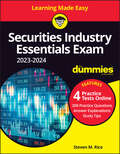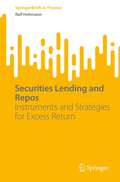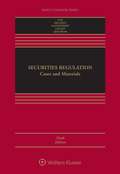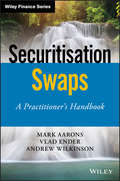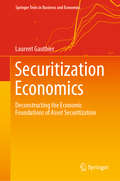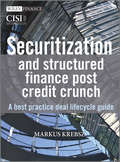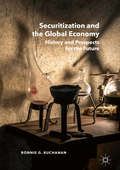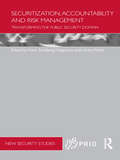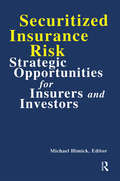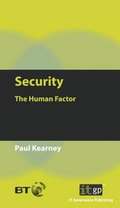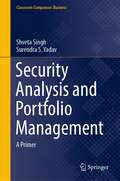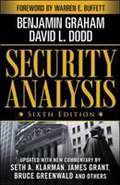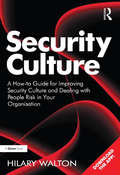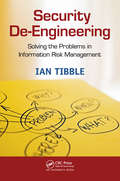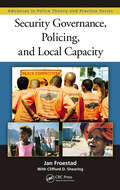- Table View
- List View
Securities Industry Essentials Exam 2023-2024 For Dummies with Online Practice
by Steven M. RiceKnock out the SIE on your first try Securities Industry Essentials Exam 2023-2024 For Dummies is this year’s definitive study guide for prospective securities industry professionals—that means you! FINRA administers this notoriously difficult exam as a prerequisite to the Series 7 and other series level exams, so you’ll need to know your stuff in order to get where you're going. Securities professionals are in high demand, and this study guide can help you become one of them. You'll have access to two complete practice tests, plus two more online! With this trusted Dummies guide, you have everything you need to get a high score on the SIE. Hundreds of practice questions help you internalize the must-know info, and we explain the content in a way you can easily grasp. You’ll go into your securities exam feeling, well, secure! Review all the content tested on the Security Industry Professionals exam Get prepared with two in-book practice tests and two more online tests Launch your dream career in the growing field of securities, commodities, and financial services Take an in-depth look at how the SIE exam is structured and how you can improve your score Let employers see how well you know your stuff—this friendly study guide is your ticket to passing the SIE.
Securities Law and Private Financing
by Michael J. Roberts Howard H. StevensonDescribes the issues an entrepreneur faces in the process of raising private funds, and the securities laws which impact the process. Based in part on a note by R.E. Floor of the law firm of Goodwin, Procter & Hoar.
Securities Law and Public Offerings
by Michael J. Roberts Howard H. StevensonDescribes the relevant securities laws which pertain to the public offering of securities, as well as the business issues and process of a public offering.
Securities Lending After the Financial Crisis
by Robert C. Pozen Gayle HameisterIn April 2009, Wendy Jefferson had just returned to her office following a whirlwind day of meetings with her newest client, Star Advisor. Jefferson, a financial services consultant, was eager to dig into the information provided to her and her team about the Star mutual funds and the income the funds earned from securities lending. Securities lending involved temporarily transferring securities from mutual funds managed by Star Advisor to short sellers and other investors. Income from these loans had been a small but secure component of Star mutual fund returns for decades.
Securities Lending and Repos: Instruments and Strategies for Excess Return (SpringerBriefs in Finance)
by Ralf HohmannThe aim of this book is to present different manifestations and conventional transactions with securities lending and repos. Securities lending as a way of short selling is not only suitable for hedging cash market positions, it is also an essential prerequisite for valuing options on the futures market. Their valuation according to the option price theory is theoretically not possible without securities lending. If, at the same time, no derivatives are traded on the market as a substitute, the valuation of a portfolio of cash and futures market positions is difficult to practice. This is unacceptable for the annual financial statements of banks, insurance companies and other capital collection agencies. With securities lending and repos, returns can be achieved with selected strategies that are above the risk-free interest rate for corresponding maturities. Market participants use differential arbitrage and compensatory arbitrage with different interest rates and premiums on the market to achieve excess returns. This is not pure short selling. Interest rates and premiums in the market should theoretically strive towards equilibrium through these transactions. Market participants thus promote market efficiency, and the resulting changes in premiums and interest rates benefit all market participants. This book targets finance professionals working in capital markets and wanting to expand their knowledge of the topic.
Securities Regulation: Cases and Materials (Aspen Casebook Series)
by James D. Cox Robert W. Hillman Donald C. Langevoort Ann M. Lipton William K. SjostromThis book contains a very teachable mix of problems, cases, and textual material, encouraging students to build their knowledge base by being active problem-solvers. Always forward-thinking, stressing current developments and controversies, the book is also highly modular, so that professors can easily pick and choose how to structure their courses without being locked into any given progression. New to the Ninth Edition: Coverage of “cryptocurrencies” and coin offerings, Commentary on market developments such as indexing and algorithmic trading, A tighter set of problems and materials on gun-jumping under Section 5, The SEC’s latest reforms of Regulation D and the intrastate offering exemption, Spotify and the trend toward direct listings as a way of going public, Coverage of Supreme Court decisions from the last three years, including Lorenzo, Salman, Cyan, Lucia, and Kokesh, as well as important lower court cases, The SEC broker-dealer proposal (and perhaps adoption) of Regulation Best Interest. Professors and students will benefit from: The book’s highly modular organization, enabling different teaching formats and coverage, Concise notes that introduce the reader to both theory and real-life practice issues. "Securities Regulation casebook for law students"- Provided by publisher.
Securities Trading: Front, Middle, and Back Office
by Francois Brochet Rakeen MabudThis note explains the basic structure of the trading floor in a typical financial institution and how the front, middle and back offices interact to ensure a functioning trading system.
Securitisation Swaps: A Practitioner's Handbook (Wiley Finance)
by Andrew Wilkinson Mark Aarons Vlad EnderDevelop the skillset essential to successful securitisation swaps management Securitisation Swaps is a complete practitioner’s guide to this unique and complex class of derivatives. This detailed examination follows the entire life cycle of securitisation swaps to give quants, structurers, traders, originators, issuers and lawyers a common reference for understanding their shared objective. Broad in scope to provide a common-ground perspective — yet detailed enough to promote full understanding — the discussion takes a distinctly cross-disciplinary approach that encompasses the multi-faceted knowledge base required to successfully execute these complex trades. Despite the fact that the size of the market is trillions of dollars in notional principal, securitisation swaps have thus far been neglected in both academic and practitioner literature. The numerous stakeholders that work together on these complex deals will all greatly benefit from a thorough understanding of their underlying risks and gain deep insight into the perspectives of each stakeholder. This invaluable guide provides multi-disciplinary insight that allows practitioners to: Manage securitisation swaps more effectively, from pre-trade structuring and modelling to post-trade risk management and accounting Understand the elements of securitisation and covered bonds, and how swaps mitigate risk in these types of transactions Explore how securitisation swaps differ from other derivatives and delve into their three specific risk factors — swap prepayment risk, swap extension risk and downgrade risk Learn practical methods and strategies of risk management, accounting, pricing and transaction execution When securitisation trades go wrong, they become front-page news — but when each participant understands accurate modelling, risk mitigation, optimal structuring, costs, pricing, commercial backgrounds and other integral practices, they are able to work together to achieve a shared objective. Securitisation Swaps provides the essential knowledge that streamlines and safeguards these important trades.
Securitising Singapore: State Power and Global Threats Management (Routledge Contemporary Southeast Asia Series)
by Syed Mohammed AljuniedAljunied examines how the Singaporean government developed a comprehensive state–society strategic relationship by ‘securitising’ vital policy areas because of Singapore’s vulnerability as a global city state. In the twenty-first century, the Singaporean government has strategically renewed an existing form of authoritarian rule by ‘militarising’ national security governance. The main objective is to widen and deepen state power. Senior military-trained civilian political leaders and bureaucrats use military personnel, command and control, terminology and strategy of war to deal with non-traditional security challenges leading to the state’s further domination over civil liberty and civil society. Aljunied analyses the information and communication, health and climate–environment sectors. The case studies highlight the way the Singaporean government has used varying forms of political engagement, surveillance and legislation to limit civil liberty and inhibit the development of civil society. This book is a valuable resource for researchers and students of Singapore Studies as well as for the readers of Security Studies with an interest in the global–local nexus in a small state context. It is a pioneering scholarly study on the national security framework and the use of non-traditional security discourse to strengthen state power and social stability at the expense of political liberalism.
Securitization Economics: Deconstructing the Economic Foundations of Asset Securitization (Springer Texts in Business and Economics)
by Laurent GauthierSecuritization is widely used around the world, and structured products are one of the largest fixed-income asset classes. This textbook guides readers through the complexity of this financial technique and first introduces them to the mechanics of securitization and makes the key concepts, techniques and logic of this field accessible for teachers and students alike. Further, the textbook presents a systematic economic analysis of securitization, asking and answering why it exists, how it works, why it has failed, how complex structures operate, why they are so complex, and many other related questions. The author offers a unique approach, and combines detailed discussions of theoretical economics models with advanced empirical research in order to confront them to the perspective of an experienced practitioner in this market.
Securitization and Structured Finance Post Credit Crunch
by Markus KrebszIn this book, you will be introduced to generic best practice principles for a post credit crunch market. First, the book takes a closer look at the reasons why the market froze during the 2007 to 2009 credit crisis. Then you will learn how to use the principles explained here in your generic deal's typical life cycle stages. Throughout, each stage is discussed in detail, from strategy and feasibility, pre-close, at close, and post close. The final section of the book contains a toolbox of references, tables, dictionaries, and resources.
Securitization and the Global Economy
by Bonnie G. BuchananThis book examines the controversial issue of securitization in a global, historical context. It traces its origins and compares evidence of securitization across countries, linking differences to variations in legal, political, and cultural regimes. By incorporating the history and current status of securitization (including sources of value and risk) with alternative markets and future outlooks for the global market, Buchanan provides an overall assessment of the costs, benefits, and sustainability of securitization in the global economy, particularly in the aftermath of the 2007-2009 financial crisis. The book also offers a roadmap for future research. As financial regulators around the world plan a sweeping overhaul of securitization markets with tough new rules designed to restore market confidence, it is essential to consider the global outlook for securitization.
Securitization, Accountability and Risk Management: Transforming the Public Security Domain (PRIO New Security Studies)
by Ulrika Mörth Karin Svedberg HelgessonThis edited volume examines the reconstitution of the public security domain since the 9/11 attacks, focusing on the banking sector and anti-money laundering (AML) activity in particular. Since the inception of the ‘Financial Action Taskforce’ (FATF) in 1989, AML has been viewed as a global problem. This text argues that the securitization of the financial sector as a result of AML has entailed the emergence of a new public security domain, which transcends the classic public-private divide. The analysis in the volume is multidisciplinary and combines concepts and theories from the literature on securitization, the public-private divide, and business/management. The authors argue that the state is under transformation and that the developments in the security field are part of an ongoing renegotiation of the relationship between the state and the business sector. Securitization, Accountability and Risk Management therefore contributes to a deeper understanding of how the power relationships have changed between the public and the private sectors after 9/11. This interdisciplinary book will be of much interest to students of critical security, risk management, business studies, critical legal studies and IR in general.
Securitization: Past, Present and Future
by Solomon Y Deku Alper KaraThis book aims to explore if and how securitization changed financial intermediation and lending behaviour by reviewing the pre- and post-financial crisis theoretical and empirical literature. The book's distinctive feature is bringing the growing post-crisis empirical evidence to the attention of a wider audience by critically appraising it against pre-crisis arguments. With its thought-provoking insights, this book is of particular interest for students, practitioners and academics.
Securitized Insurance Risk: Strategic Opportunities for Insurers and Investors (Glenlake Business Monographs)
by Michael HimickSecuritized Insurance Risk is one of the first books to focus exclusively on the convergence of the insurance and financial markets in risk management and the emergence of insurance risk as a non-correlated asset class. Written for insurers and investors alike, this book explores the opportunities available to forward-looking risk and investment managers. Chapters by prominent experts specifically address: the win-win principle behind securitizing insurance risk; current structures, including catastrophe bonds, structured notes, catastrophe options, and swaps; partnering financial market tools with traditional reinsurance programs; holding insurance risk, uncorrelated with stocks and bonds; pricing insurance risk instruments and evaluating basic risk; and regulatory and accounting concerns.
Security
by Philippe BourbeauSecurity is a vital subject of study in the twenty-first century and a central theme in many social science disciplines. This volume provides a comparative analysis of the ways in which the concept of security is theorized and studied across different disciplines. The book has two objectives: first, to explore the growing diversity of theories, paradigms, and methods developed to study security; and, second, to initiate a multidisciplinary dialogue about the ontological, epistemological, paradigmatic, and normative aspects of security studies in social sciences. Readers across nine fields are invited to reflect on their conceptualizations of security and to consider how an interdisciplinary dialogue can stimulate and enrich the understanding of security in our contemporary world. Analytically sharp yet easy to read, this is a cutting-edge volume exploring what security is and what it means in today's world.
Security - The Human Factor
by Paul KearneyAddress human vulnerabilities with this essential guide . . . Practical advice from an acknowledged expert - endorsed by BT!Your business information is likely to be much more valuable than the hardware on which it is stored. The loss of a laptop might set you back £400, but if the files on the laptop included sensitive customer data or the blueprint for a new product, the cost of repairing the damage would run into thousands. The consequences of a data breach range from alienating customers to heavy fines, or even criminal prosecution. While technologies, such as antivirus software and encryption, can offer some protection against cybercrime, security breaches are most often the result of human error and carelessness. Improve information securityImproving information security within your organisation, therefore, has to encompass people and processes, as well as technology. Motivating your team and making them more aware of security concerns should be at the heart of your information security strategy. At the same time, the processes you have in place to address information security issues need to be straightforward and properly understood if you want your employees to adhere to them. BT's approachThis pocket guide is based on the approach used by BT to protect its own data security - one that draws on the capabilities of both people and technology. The guide will prove invaluable for IT managers, information security officers and business executives.
Security Analysis and Business Valuation on Wall Street + Companion Web Site
by Hooke Jeffrey C.An insider's look at security analysis and business valuation, as practiced by Wall Street, Corporate America, and international businesses Two major market crashes, numerous financial and accounting scandals, growth in private equity and hedge funds, Sarbanes Oxley and related regulations, and international developments changed security analysis and business valuation substantially over the last fourteen years. These events necessitated a second edition of this modern classic, praised earlier by Barron's as a "welcome successor to Graham and Dodd" and used in the global CFA exam. This authoritative book shows the rational, rigorous analysis is still the most successful way to evaluate securities. It picks up where Graham and Dodd's bestselling Security Analysis - for decades considered the definitive word on the subject - leaves off. Providing a practical viewpoint, Security Analysis on Wall Street shows how the values of common stock are really determined in today's marketplace. Incorporating dozens of real-world examples, and spotlighting many special analysis cases - including cash flow stocks, unusual industries and distressed securities - this comprehensive resources delivers all the answers to your questions about security analysis and corporate valuation on Wall Street. The Second Edition of Security Analysis on Wall Street examines how mutual funds, private equity funds, hedge funds, institutional money managers, investment banks, business appraisers, and corporate acquirers perform their craft of security analysis and business valuation in today's highly charged environment. Completely updated to reflect the latest methodologies, this reliable resource represents the most comprehensive book written by someone who has actually worked as an investment banker, private equity executive, and international institutional investor. Shows the methodical process that practitioners use to value common stocks and operating companies and to make buy/sell decisions Discusses the impact of the two stock market crashes, the accounting and financial scandals, and the new regulations on the evaluation process Covers how Internet and computing power automate portions of the research and analytical effort Includes new case study examples representative of valuation issues faced daily by mutual funds, private equity funds, hedge funds, institutional investors, investment banks, business appraisers, and corporate acquirers Is a perfect tool for professors wishing to show their MBA students the essential tools of equity and business valuation Security analysis and business valuation are core financial disciplines for Wall Streeters, corporate acquirers, and international investors. The Second Edition of Security Analysis on Wall Street is an important book for anyone who needs a solid grounding in these critical finance topics.
Security Analysis and Portfolio Management: A Primer (Classroom Companion: Business)
by Shveta Singh Surendra S. YadavThis book is a simple and concise text on the subject of security analysis and portfolio management. It is targeted towards those who do not have prior background in finance, and hence the text veers away from rather complicated formulations and discussions. The course ‘Security Analysis and Portfolio Management’ is usually taught as an elective for students specialising in financial management, and the authors have an experience of teaching this course for more than two decades. The book contains real empirical evidence and examples in terms of returns, risk and price multiples from the Indian equity markets (over the past two decades) that are a result of the analysis undertaken by the authors themselves. This empirical evidence and analysis help the reader in understanding basic concepts through real data of the Indian stock market. To drive home concepts, each chapter has many illustrations and case-lets citing real-life examples and sections called ‘points to ponder’ to encourage independent thinking and critical examination. For practice, each chapter has many numericals, questions, and assignments
Security Analysis: Sixth Edition, Foreword By Warren Buffett
by Benjamin Graham David DoddFirst published in 1934, Security Analysis is one of the most influential financial books ever written. Selling more than one million copies through five editions, it has provided generations of investors with the timeless value investing philosophy and techniques of Benjamin Graham and David L. Dodd. As relevant today as when they first appeared nearly 75 years ago, the teachings of Benjamin Graham, “the father of value investing,” have withstood the test of time across a wide diversity of market conditions, countries, and asset classes. This new sixth edition, based on the classic 1940 version, is enhanced with 200 additional pages of commentary from some of today’s leading Wall Street money managers. These masters of value investing explain why the principles and techniques of Graham and Dodd are still highly relevant even in today’s vastly different markets. The contributor list includes: Seth A. Klarman, president of The Baupost Group, L.L.C. and author of Margin of Safety James Grant, founder of Grant's Interest Rate Observer, general partner of Nippon Partners Jeffrey M. Laderman, twenty-five year veteran of BusinessWeek Roger Lowenstein, author of Buffett: The Making of an American Capitalist and When America Aged and Outside Director, Sequoia Fund Howard S. Marks, CFA, Chairman and Co-Founder, Oaktree Capital Management L.P. J. Ezra Merkin, Managing Partner, Gabriel Capital Group . Bruce Berkowitz, Founder, Fairholme Capital Management. Glenn H. Greenberg, Co-Founder and Managing Director, Chieftain Capital Management Bruce Greenwald, Robert Heilbrunn Professor of Finance and Asset Management, Columbia Business School David Abrams, Managing Member, Abrams Capital Featuring a foreword by Warren E. Buffett (in which he reveals that he has read the 1940 masterwork “at least four times”), this new edition of Security Analysis will reacquaint you with the foundations of value investing—more relevant than ever in the tumultuous 21st century markets.
Security Capital Pacific Trust: A Case for Branding
by Susan FournierA real estate operations and investment trust is considering whether it should pursue branding as a strategic investment. Through interpretation of case data and video from focus groups, students deduce the consumer (cognitive, psychological, and economic), environmental, and company factors that are conducive to branding, thereby illuminating their understanding of when it makes sense to brand. Analysis of extensive survey data allows students to consider the secondary question about how to brand as they formulate brand-positioning recommendations. Includes color exhibits.
Security Capital Pacific Trust: A Case for Branding
by Susan FournierA real estate operations and investment trust is considering whether it should pursue branding as a strategic investment. Through interpretation of case data and video from focus groups, students deduce the consumer (cognitive, psychological, and economic), environmental, and company factors that are conducive to branding, thereby illuminating their understanding of when it makes sense to brand. Analysis of extensive survey data allows students to consider the secondary question about how to brand as they formulate brand-positioning recommendations. Includes color exhibits.
Security Culture: A How-to Guide for Improving Security Culture and Dealing with People Risk in Your Organisation
by Hilary WaltonSecurity Culture starts from the premise that, even with good technical tools and security processes, an organisation is still vulnerable without a strong culture and a resilient set of behaviours in relation to people risk. Hilary Walton combines her research and her unique work portfolio to provide proven security culture strategies with practical advice on their implementation. And she does so across the board: from management buy-in, employee development and motivation, right through to effective metrics for security culture activities. There is still relatively little integrated and structured advice on how you can embed security in the culture of your organisation. Hilary Walton draws all the best ideas together, including a blend of psychology, risk and security, to offer a security culture interventions toolkit from which you can pick and choose as you design your security culture programme - whether in private or public settings. Applying the techniques included in Security Culture will enable you to introduce or enhance a culture in which security messages stick, employees comply with policies, security complacency is challenged, and managers and employees understand the significance of this critically important, business-as-usual, function.
Security De-Engineering: Solving the Problems in Information Risk Management
by Ian TibbleAs hacker organizations surpass drug cartels in terms of revenue generation, it is clear that the good guys are doing something wrong in information security. Providing a simple foundational remedy for our security ills, Security De-Engineering: Solving the Problems in Information Risk Management is a definitive guide to the current problems i
Security Governance, Policing, and Local Capacity (Advances in Police Theory and Practice)
by Clifford Shearing Jan FroestadThe security governance of South Africa has faced immense challenges amid post-apartheid constitutional and political transformations. In many cases, policing and governmental organizations have failed to provide security and other services to the poorest inhabitants. Security Governance, Policing, and Local Capacity explores an experiment that too
